Fix: HDMI Sound Not Working
The HDMI (high definition multimedia interface) made a tremendous stride in video and audio streaming when it finally allowed uncompressed media streaming hence clearer and sharper images and sound. Using only one cable/port, users could now stream audio and video to their monitors and TVs including 4K content. While the technology has been seamless, several users have always complained that their HDMI connection can show the video but there is no sound accompanying it. This article will explore this issue and give working solutions to the problem.

Why HDMI Sound Does Not Work
There are several reasons why your HDMI sound might not be working. The problem could be anywhere from your PC, the HDMI cable, to your monitor or TV. Start by plugging your HDMI to another PC. If the issue persists, then the cable or your monitor/TV is likely to be the issue; if not, then the PC might be the issue. Also, try using another HDMI cable that is known to be functioning. If the problem remains, then your PC or your monitor/TV might be the issue. You can also use try using another TV/Monitor to narrow down the problem further.
HDMI cables can easily be replaced. However, if the PC is the issue, then there might be different reasons for the problem. It might be caused by an incompatible or wrong driver or even a selection of the wrong playback device. Your internal speakers’ soundcard might have been set as the default device hence the PC is unable to switch from speakers to HDMI audio output. You monitor or TV might also not have been configured to receive the HDMI audio. This problem has also been seen in conflicting drivers where drivers that depend on each other had been disabled hence the sound card was not able to function properly. Below are the solutions to the problem. But before moving on, keep the cable plugged in and restart the devices. Also, make sure the cable is not faulty. Do not forget to check your Graphics Card e.g. Nvidia Control Panel for any wrong configuration. Do note that pre-GeForce 200 series Nvidia cards don’t support HDMI audio. Realtek drivers are known to have this issue.
Method 1: Enable and Make Your HDMI the Default Playback Device
Windows easily lets you switch from your speakers to your HDMI audio output from the system tray. However, by making your speakers the default playback over your HDMI output, the computer will not be able to switch to the HDMI output whenever it is plugged in. This is quite common whenever a PC has more than one graphics or sound card.
- Press Windows + R Key to open Run
- Type mmsys.cpl and hit enter to open the sound and audio device settings window.
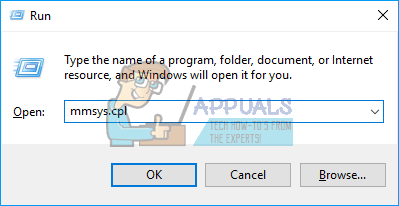
Run mmsys.cpl command - Go to the playback tab. Now plug in your HDMI cable. It should appear on the list usually with the name of the monitor or TV. If not, right-click anywhere on the list and make sure that the “Show Disabled Devices” and the “Show Disconnected Devices” options are checked.
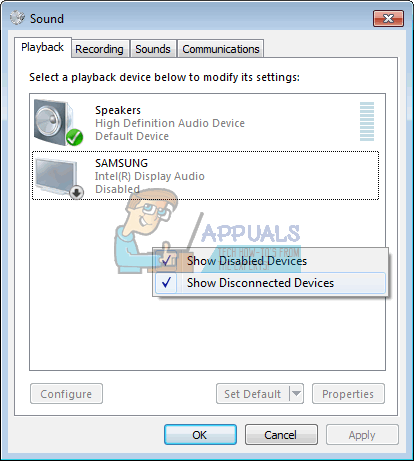
Show Disabled Devices - If there is an HDMI audio device that is disabled, right-click on it and select “Enable”
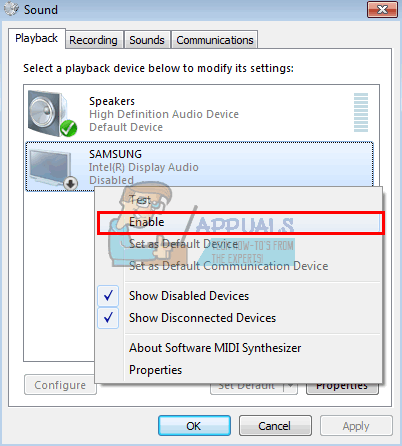
Enable HDMI Audio Device - Now click on your HDMI output device to select it. At the bottom click “Set as default” to bring it online whenever it is connected. Click OK to exit.
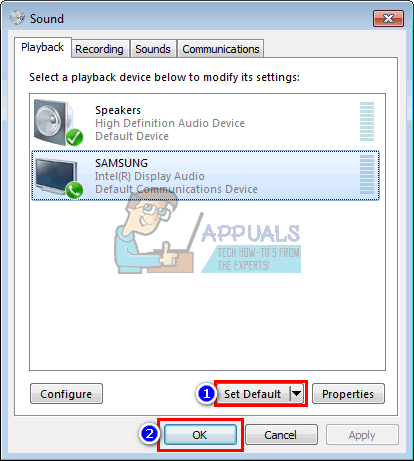
Set HDMI Device as Default
Method 2: Update your drivers
The best way to get your drivers is to go online to your audio card manufacturer or your PC manufacturer (additional audio features will be supported), download the audio drivers and then install them on your PC. For Dell users, you can go here to download your drivers. HP users can go here. You can also update your drivers over the internet by following the steps below.
- Press Windows Key + R to open Run
- Type devmgmt.msc and hit enter to open the device manager

Run devmgmt.msc Command - Expand the ‘sound, video and game controller’ section
- Right-click on your audio device, and select ‘update driver software’. An internet connection will give you better results.
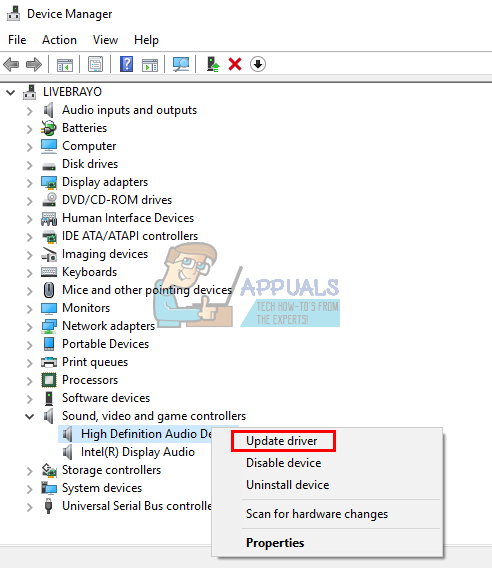
Update Driver in Device Manager
- On the next window click “Search automatically for updated driver software”
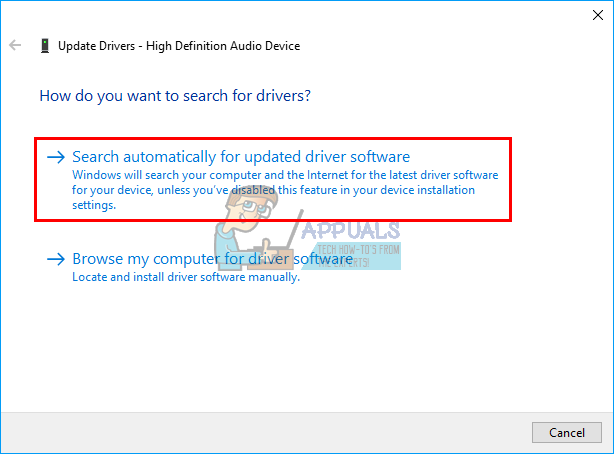
Search Automatically for Updated Driver Software - The device manager will search for drivers online and install them.
Method 3: Rollback your graphics drivers
HDMI video and audio are tied to your graphics processor. If your HDMI had been working previously and suddenly couldn’t work again (especially after some update) then you will need to roll back to the graphics drivers that previously functioned.
- Press Windows Key + R to open Run
- Type devmgmt.msc and hit enter to open the device manager

Run devmgmt.msc Command - Expand the ‘Display Adapters” section
- Right-click on your driver and select ‘properties’
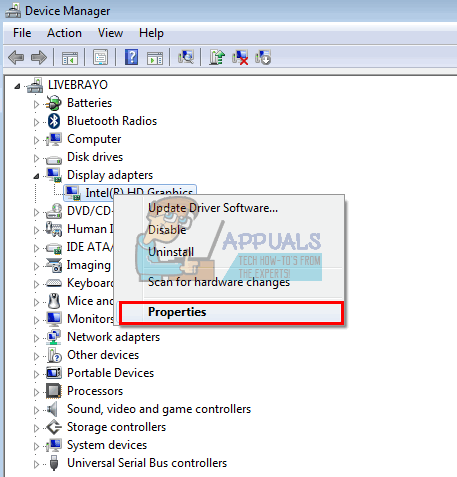
Open Properties of the Device - Go to the ‘Driver’ tab and click “Roll Back Driver”
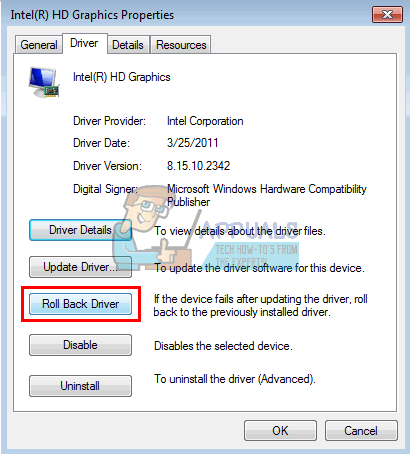
Roll Back Driver - Click ‘Yes’ on the warning/confirmation message box and wait for your drivers to be rolled back. You might have to restart your computer for effect to take place.
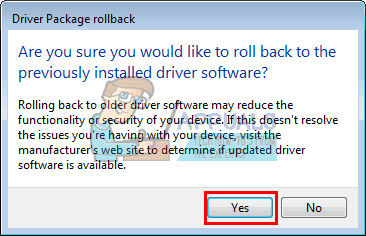
Confirm to Roll Back Driver
Method 4: Enable all Audio Controllers
Audio controllers allow windows to automatically determine the audio behavior of your system. Disabling these controllers will lead to malfunctioning of your audio output swapping.
- Press Windows Key + R to open Run
- Type devmgmt.msc and hit enter to open the device manager

Run devmgmt.msc Command - On the menu, click on ‘View’ and then select “view hidden devices” (if not checked already)

Show Hidden Devices in Device Manager - Expand the ‘System Devices” section
- Look for audio controllers, e.g. ‘High Definition Audio Controller’
- Right Click on the device and go to ‘Properties’.
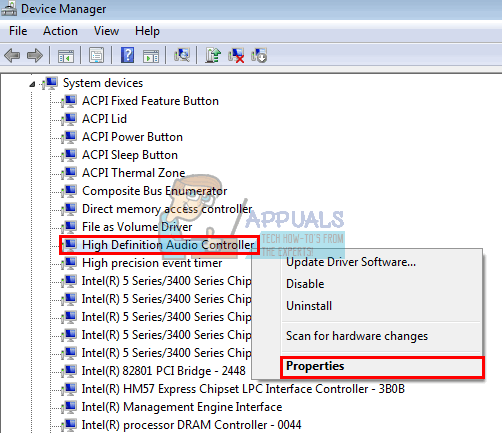
Open Properties of Device - Go to the ‘Driver’ tab and click on ‘Enable’ if you have that option (it means your controller is disabled)
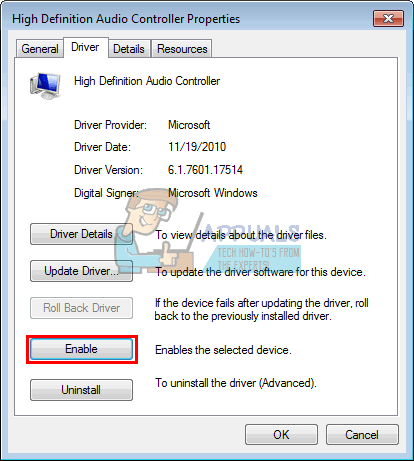
Enable Driver - If you have more than one audio controller, make sure all are enabled. Restart your PC if you are prompted; for effect to take place.

Confirm to Restart Computer
Method 5: Uninstall and reinstall Display Audio and Audio Controllers
Whenever you plug in your HDMI, a new device might appear in your device manager within the sound section. If the drivers for this are not functioning correctly, then you might have a sound output problem. Uninstalling these drivers and restarting your PC will automatically reinstall the correct drivers from the Windows repository.
- Plugin your HDMI output cable and connect it to your TV or monitor
- Press Windows Key + R to open Run
- Type devmgmt.msc and hit enter to open the device manager

Run devmgmt.msc Command - Expand the ‘sound, video and game controller’ section
- Right-click on the ‘Intel Display Audio’ device (you can find the equivalent for your PC by plugging and unplugging the HDMI and see which device is affected), and select ‘Uninstall’.
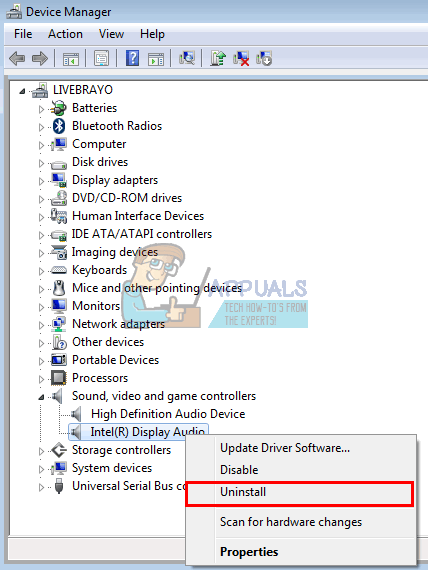
Uninstall Device in Device Manager - Confirm that you want to uninstall by clicking ‘OK’ on the warning message
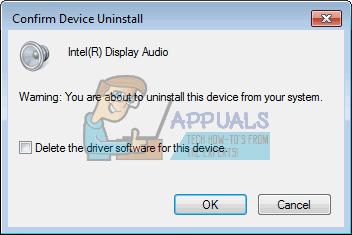
Confirm to Uninstall Device - Now expand the ‘System Devices’ section
- Look for audio controllers, e.g. ‘High Definition Audio Controller’
- Right Click on the device and go to ‘Uninstall.
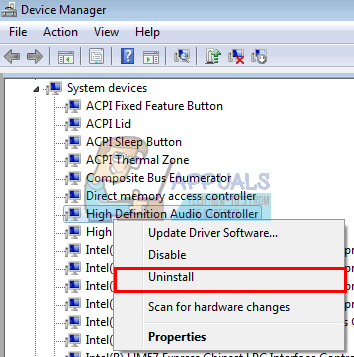
Uninstall Device in Device Manager - Confirm that you want to uninstall by clicking ‘OK’ on the warning message
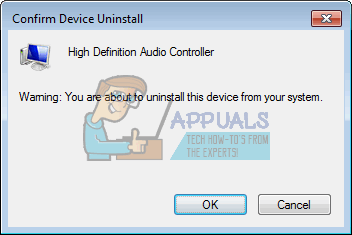
Confirm to Uninstall the Device - If you have more than one audio controller, make sure you uninstall all of them.
- With your HDMI still plugged in, restart your PC. Windows will automatically install the correct drivers from its repository. You might need to restart your PC again if prompted.
You might also want to check the “Other Devices” section and install all devices with yellow exclamations.
Method 6: Change your monitor or TV audio settings
Besides changing the obvious things like setting your TV input source to the corresponding HDMI input port and making sure that the cable is seated correctly and firmly or that the TV is not on mute, you can also try tweaking the TV/Monitor sound properties.
- Go to your TV/Monitor menu > Settings > audio and try changing the audio coding to automatic or to HDMI. Make sure that your audio is automatic or HDMI audio is enabled.
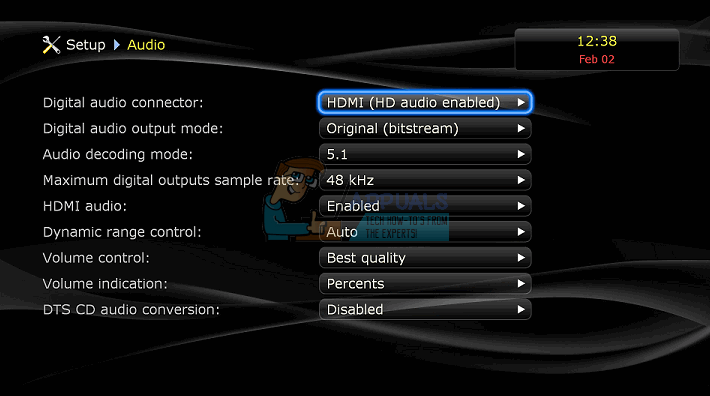
Change Audio Connector to HDMI - You can also try toggling the ‘Dolby Volume Mode’ to OFF and see if it helps (known issue in some TVs)
- Try toggling the ‘Audio Range’ between WIDE and NARROW or any other setting you have (stereo, mono, standard, etc.).
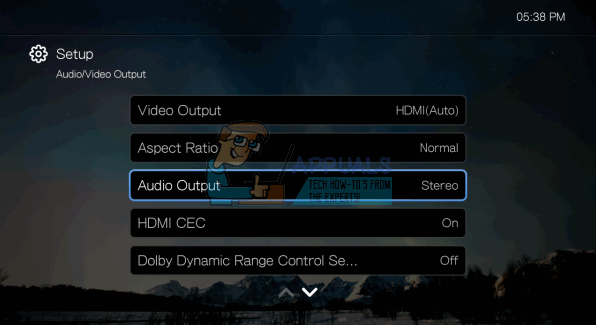
Change Audio Output to Stereo
The HDMI graphics card may support HDMI Video, but may not support HDMI Audio; if your HDMI video card does not support audio, you may need to connect additional audio cables between the PC and TV.
Method 7: Use Sound Troubleshooter
Windows has a lot of built-in troubleshooters to troubleshoot common Windows issues. One of these is the Sound troubleshooter. As the name suggests, this troubleshooter tests your current sound hardware with the software components and if it finds any discrepancies, it automatically fixes it by restart/reinitializing either components. Make sure that you are logged in as an administrator before proceeding.
- Press Windows key, type Troubleshoot and in the resulting list, click on Troubleshoot Settings.

Open Troubleshoot Settings - In the right pane of the window, scroll down till you find and click Playing Audio, then click on Run this troubleshooter.
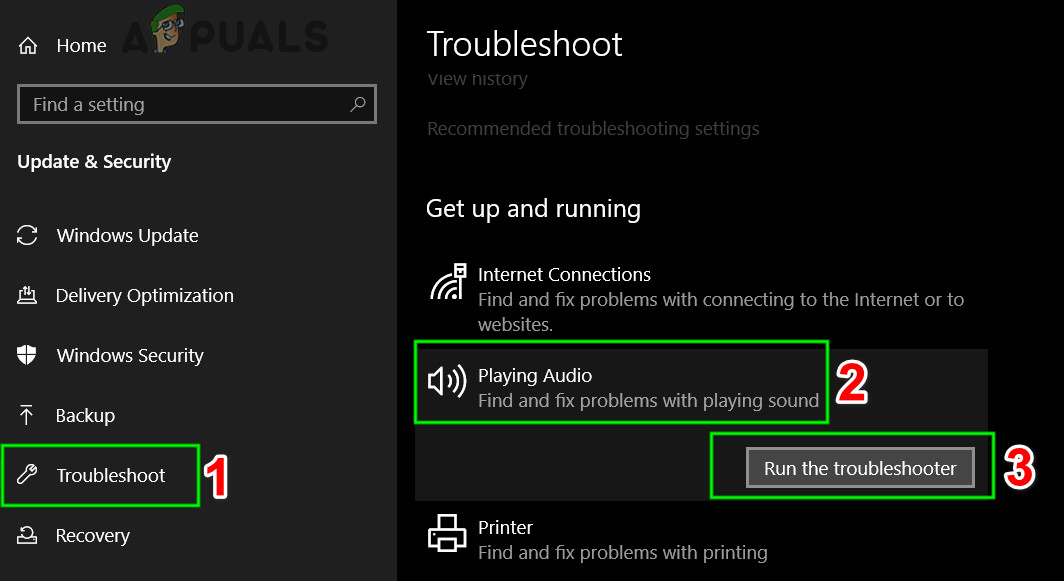
Troubleshoot Playing Audio - Follow the instructions shown on the screen to complete the troubleshooter. Restart your computer after the progress and completed and check if you can access the sound through HDMI or not.
Note: If you cannot listen to the sound through HDMI even after performing all the above solutions, we recommend that you check the same HDMI/HDMI source with another system. If it is also occurring there, it means there is no issue with the computer. If the other system works fine, then consider doing a clean install or inspecting your ports.